Comments by our readers are important. They are often our “truth squad,” pointing out errors (which we gratefully and immediately correct), debunking claims and deflating pompous rhetoric. Long may they be vigilant. What follows is a series of exchanges between one of the three researchers who produced the London conference Ceramics in the Expanded Field, Christie Brown and one of the speakers, Ezra Shales.
Above image: Ezra Shales
The catalyst was a thoughtful review by CFile’s Janet Abrams and it drew praise:
Vasi Hirdo There should be more gatherings like this one, but they should probably focus more on interdisciplinary dialogue and inviting external expertise if the organizers want to reach their very ambitious goals. This is a great review, btw.
Peter C. Johnson It is nice to read a detailed and thoughtful review like this that draws attention to the complications and challenges the field of ceramics is facing.
A few clarifiers before reading Brown and Shales: the exhibition segment only featured the project’s three researchers; Brown, Julian Stair and Claire Twomey. Whether intentional or not it made the researchers and not the research the focus of the event.
Secondly, Brown takes me to task in saying that the event was “three years in the making” whereas she claims it only took three months. To prepare for and present a major international conference in three months seems implausible if not unprofessional. I would like to draw her attention to this web entry following a link that she provided:
Nov 14, 2011 – A major research project from the Ceramics Research Group at the University of Westminster funded by the Arts and Humanities Research.
I cannot comment on Shales’ presentation at the conference but reports confirm that it was indeed lengthy. If you want to have a sense of his writing on the subject, however, here is an essay posted on the “Expanded” site. Here come the comments:
Ezra Shales: A few slightly more candid remarks from a participant who regrets attending:
a. it was a mediocre conference that ticked off the boxes of funding for university-research and careerism. The “legacy” mongering of the mima museum (Middlesbrough Institute of Modern Art – ed.) was part of this pervasive self-congratulatory adulation. The participants had been in those exhibitions; the curator was a swell. Nary a critical reflection or regret was articulated.
b. 90% of the presentations were designed to highlight Westminster U., not an expanded field.
c. the reviewer’s suggestion that a more expansive field would be additional contemporary art is a joke and what makes most craft-media conferences a joke –“oh, yes, let’s invite Peter Schjeldahl or Roberta Smith for approbation” is the norm.
d. the Oedipal urge in craft is a curious thing. Abrams should either have turned a critical eye to Theaster Gates’s talk (don’t wait on that to happen in fortress ceramica) or written a confessional about Cranbrook and her ambivalence about getting an MFA.
Let’s sort it out. What are our aims? Where are we going? The want of criticism in ceramics is usually because it is sacrificed before careerism, cronyism, or capitalist expectations. The third distraction is probably the most laughable as the pot is small.Christie Brown: Ezra Shales is perfectly at liberty to engage in critical debate about our conference (only 3 months in the planning and specifically about museum engagement, for the record Garth, see http://www.ceramics-in-the-expanded-field.com) but a more constructive approach would be welcome. As a participant who regrets attending, he neglects to say he was paid a lecture fee as well as travel and accommodation expenses for the delivery of an interesting but overlong paper, which did not seem to have been written for our conference. As he only attended one evening and one day of this 3-day event, allegedly slept through much of the afternoon on day 2 and missed several strands and keynotes as a result, this attack is somewhat one-sided, although Ezra’s final 2 questions are a welcome note of objectivity in this discussion. He is fully entitled to criticize what he sees as lack of critical reflection but would be better placed to do so if he had the full picture.
Ezra Shales I appreciate that Christie points out my feet of clay but she doesn’t really answer my question: Is the self-promotional conference peculiarly indicative of the careerist academic art of our time?
On the topics of my many faults: I think the keynote presenter did not attend another minute of the conference other than his own. But I suppose those folks are supposed to blow you off whether you are boring or not. I am glad that I spent day two at the Imperial War Museum, Christie; I only told you that I was ill and stayed at the hotel to try and be polite.
My own self-loathing did extend to turning down the opportunity to publish my “overlong” sermon with the Westminster Clay Cooperative Gang of Three. It did seem like bad karma or at least an avoidable extension of my carbon footprint.
And my inappropriate lack of gratitude: Yes, I was lucky to stay in the Sherlock Holmes Plaza courtesy of the conference and had a fab free meal with a select crowd but not several presenters, such as Mr. Ruhwald, who was not invited to dinner.
And I regret not saying that I enjoyed Phoebe Cummings’s talk, too. But my point is more broad. Let’s ask ourselves how we might distinguish between facebook “likes” and genuine discourse and criticism.
Mind the pugmill and be of good cheer!
CFile would particularly like to hear more from those who attended the event.
Garth Clark is Chief Editor of CFile.
Any thoughts about this post? Share yours in the comment box below.

Add your valued opinion to this post.